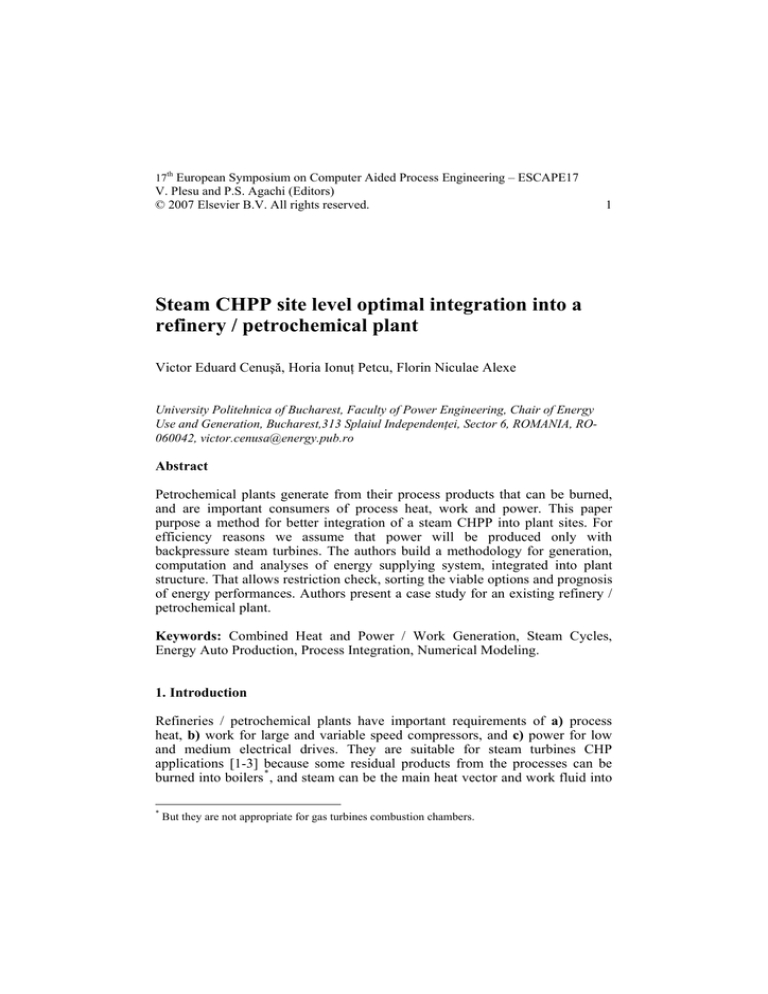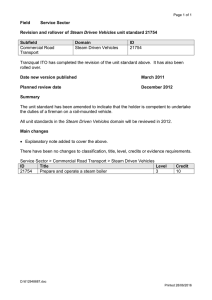
17th European Symposium on Computer Aided Process Engineering – ESCAPE17
V. Plesu and P.S. Agachi (Editors)
© 2007 Elsevier B.V. All rights reserved.
1
Steam CHPP site level optimal integration into a
refinery / petrochemical plant
Victor Eduard Cenuşă, Horia Ionuţ Petcu, Florin Niculae Alexe
University Politehnica of Bucharest, Faculty of Power Engineering, Chair of Energy
Use and Generation, Bucharest,313 Splaiul Independenţei, Sector 6, ROMANIA, RO060042, victor.cenusa@energy.pub.ro
Abstract
Petrochemical plants generate from their process products that can be burned,
and are important consumers of process heat, work and power. This paper
purpose a method for better integration of a steam CHPP into plant sites. For
efficiency reasons we assume that power will be produced only with
backpressure steam turbines. The authors build a methodology for generation,
computation and analyses of energy supplying system, integrated into plant
structure. That allows restriction check, sorting the viable options and prognosis
of energy performances. Authors present a case study for an existing refinery /
petrochemical plant.
Keywords: Combined Heat and Power / Work Generation, Steam Cycles,
Energy Auto Production, Process Integration, Numerical Modeling.
1. Introduction
Refineries / petrochemical plants have important requirements of a) process
heat, b) work for large and variable speed compressors, and c) power for low
and medium electrical drives. They are suitable for steam turbines CHP
applications [1-3] because some residual products from the processes can be
burned into boilers * , and steam can be the main heat vector and work fluid into
*
But they are not appropriate for gas turbines combustion chambers.
2
V. Cenuşă et al
compressors driving turbines [4]. We will consider a refinery / petrochemical
plant site with process energy requirements optimized and known. Will be
accepted changes only in large process compressors drive solutions. Into
improved design, those will be exclusively driven by electric motors or
backpressure steam turbines. Beside Combined Heat and Work (CHW), assured
by process turbines, Combined Heat and Power (CHP) with extraction and
backpressure steam turbines will be introduced. The general CHW / CHP
design is based on high parameters steam production, expansion in steam
turbines for electricity or work generation and use of exhaust (extractions and
backpressure) for covering heat demands.
The scope of CHW / CHP is to minimize energy acquisition, plant’s energy bill
and primary fuel consumption, respectively CO2 emissions. This paper, based
on thermodynamic modeling of the cogeneration processes, follows energy and
mass flows optimization for better integration of a steam CHW / CHP into sites.
2. Methodology
Authors build a methodology for generation, computation and analyses of
system layouts witch allows: a) restriction check and sort the viable options, b)
annual energy consumption prognosis for the chosen schedule. Due to the
complexity, the problem can be solved only numerical and for given data.
First step is analyzing electricity and heat consumption (those will be grouped
on maximum three pressure levels). After statistical evaluation, demand curves
for electricity and heat (by levels) will be assigned, and energy demand
correlations between electricity and heat will be established.
The second step is the process compressor drives analyses for their energy
rationalizes. Condensing steam turbines drives will be eliminated and only
electrical and backpressure steam turbines options will be retained.
One important step is the generation of steam links schedule packages for the
CHW / CHP generation. For simplification, the number of steam feeders will be
limited to 4. The highest-pressure level will be at live steam feeder for CHP.
Main steam for CHW turbines will be ensured by a steam feeder having a
pressure higher or equal to the maximum pressure required by process heating.
CHW turbines will ensure links between their live steam feeder and heat user’s
feeders. Backpressure and extractions CHP turbines, backpressure CHW
turbines and, peak or emergency steam boilers will balance heat demand.
Process cogeneration restrictions check for generated schedules begin with
exclusive steam backpressure compressors drives case. If computed heat flow
on a feeder from CHW exceeds needed level, the schedule is rejected. If in all
the schedules we have exceeding heat flows on heat consumer’s feeders, we
accept electrical drive for at least a compressor * . In consequence, new steam
*
For given plants existing electrical drive will be maintained. For new plants, the process will
begin with the smallest compressor.
Steam CHPP site level optimal integration into a refinery and petrochemical plant
3
links schedule packages will be generated * . The schedule generation process
will stop when a valid solution is obtained. This is the maximal CHW solution.
Once the CHW schedule is fixed we select the CHP schedule and determine the
thermal loads for CHP turbines. CHP steam turbines number must be at
minimum two. After that we can compute electrical power obtained for a
reference load.
The final step is system modeling of stationary off design running, for various
loads. The purpose is energy consumption calculus, through numerical
integration of load curves.
3. Case study
The case study is realized for an existing 2,500,000 tones per year oil capacity
refinery. This plant is in operation average 11 months yearly. Historical
electrical and heat load curves are presented in the figures 1 and 2.
240
160
Fuel-prognosis
Fuel-existing
Steam 11 bar
Steam 28 bar-existing
Steam 3.6 bar
Steam 28 bar-prognosis
120
80
40
0
0
2010
4020 6030
Time,h
Figure 1. Heat load curves.
8040
Electicity flow,MW
Heat flow,MW .
200
27
24
21
18
15
12
9
6
3
0
Electricity acquisitionexisting
Electricity
autoproduced-prognosis
Electricity acquisitionprognosis
0
2010
4020 6030
Time,h
8040
Figure 2. Power load curves.
This refinery has 3 main compressors: C#1 with Pmk = 1.8 MW (maximal
mechanical power demand) at n = 12,400 rpm (rotation speed) and driven by a
backpressure steam turbine; C#2, Pmk = 3.6 MW at n = 7,350 rpm, driven by a
condensing steam turbine and C#3 with Pmk = 3.8 MW at n = 7,150 rpm,
electrical driven. On the existing schedule (see figure 3) we find 3 steam feeders
supplied by boilers. Boiler’s feed water has a temperature of 104 ºC.
Maximal pressure of steam boilers is equal to maximal consumed steam
pressure and equal to motor steam pressure for process turbines. Others heat
*
For low heat demands, successive elimination process can be with no CHW solution, only
electrical compressor drives.
4
V. Cenuşă et al
consumers are grouped on two thermal levels: intermediate and low pressure.
CHP do not exist into present installation and CHW is used only for C#1.
Annual fuel and electricity consumption for present situation is given on the
first column of table 1.
Figure 3. Existing CHW schedule.
Figure 4. Proposal CHW / CHP schedule.
Steam CHPP site level optimal integration into a refinery and petrochemical plant
5
First proposed package of generated schedules was with existing live steam
pressure and development of CHW for C#2. Heat delivery being bigger then
minimum of thermal load for existing two pressure levels, restriction check
eliminated all variants, unaffected by pressure combinations of the CHW
backpressure levels. This think eliminated any interest for electricity
cogeneration for these live steam parameters.
For CHP implementing, next step brings 4 steam feeder schedules (see figure 4)
with higher live steam pressure for energy boilers (64 bar) and feed water
preheating temperature 210 ºC. The driving solution with backpressure steam
turbines of 1.8 MW / 11.2 bar, for C#1, and 3.6 MW / 3.6 bar, for C#2, satisfy
exhausted heat restriction check.
The two CHP backpressure and extraction turbines were calculated for base and
semibase coverage of 28, 11.2 and 3.6 bar steam feeders. Existing steam boilers
will be maintained as peak and emergency units. Nominal power of the two
CHP steam turbines resulted 14 and respectively 12 MW.
Modeling of the CHW /CHP and peak steam sources system for 44 off-design
regimes, based on load curves, permitted the calculation of fuel and electricity
consumption. For an easy comparison with existing situation, new electrical and
heat load curves are presented together with the old ones in figures 1 and 2.
Annual fuel and electricity consumption for the improved schedule are
presented on second column of table 1.
Table 1.Economical and ecological results
Existing
Electricity acquisition, MWh / year
Future
Difference
174,571
20,444
55
55
Electricity bill, Euro / year
9,601,429
1,124,400
-8,477,029
Fuel consumption, MWh / year
1,461,912
1,591,642
129,730
25
25
Fuel bill, EURO / year
36,547,800
39,791,062
3,243,262
Energy bill, EURO / year
46,149,229
40,915,462
-5,233,767
Electricity cost, EURO / MWh
Heat cost, EURO / MWh
-154,128
The case study demonstrated that proposed solution, due to CHP / CHW
efficiency, reduces ten times the electricity acquisition comparing with existing
situation and growth the fuel consumption with less then 10 %. Because burned
fuel heat’s cost is lower then electricity cost [5], operational energy expenses of
the plant are diminishing with a factor of 1.13 * .
*
The prices in table 1 correspond to the Romanian ones.
6
V. Cenuşă et al
4. Conclusions and future work
The main conclusion of the paper is that use of CHW / CHP generation into a
petrochemical / refinery plant brings positive economical effects through
operational expenses diminish. From sustainable development point of view [6,
7], if electricity consumed in present by the plant is generated in Romania, with
condensing steam turbines at 32 % * global efficiency, the solution brings
99,768 tones CO2 emission reduction per year. Even if electricity is produced
with advanced thermodynamic conversion cycles, these can’t achieve global
efficiency of cogeneration cycles. So these conclusions remain, only the figures
will be others.
Into a future stage, the authors will examine exclusive CHP generation
schedules using high steam parameters and electrical drives for process
compressors.
Bibliography
1. P. Kiameh, Power Generation Handbook, McGraw-Hill, New York (2002).
2. A. Goršek, P. Glavič, Process integration of a steam turbine, Applied Thermal Engineering
23 (2003) 1227–1234.
3. M. Siddhartha Bhatt, Mapping of general combined heat and power systems, Energy
Conversion & Management 42 (2001) 115-124.
4. B.J. Zhang and B. Hua, Effective MILP model for oil refinery-wide production planning
and better energy utilization, Journal of Cleaner Production (accepted 18 August 2005).
5. J.L. Silveira, C.E. Tuna, Thermoeconomic analysis method for optimization of combined
heat and power systems, Progress in Energy and Combustion Science, part I, 29 (2003)
479–485, part II, 30 (2004) 673–678.
6. European Commission, Integrated Pollution Prevention and Control (IPPC), Reference
Document on Best Available Techniques for Mineral Oil and Gas Refineries (2003).
7. G. Montero, and oth., Ecotaxes and their impact in the cost of steam and electric energy
generated by a steam turbine system, Energy 31 (2006) 3391–3400.
*
This includes plants efficiency and transport losses.




